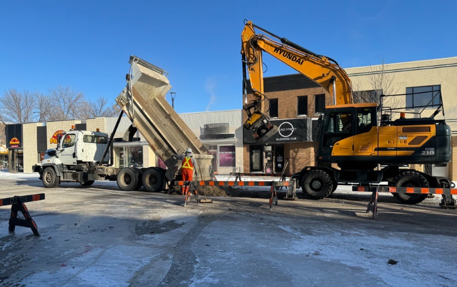Extreme weather vs City Infrastructure; Cold snap challenges in numbers
The recent extreme cold weather may have put a freeze on the regular routines of residents, but it certainly turned up the heat on several City of Lethbridge crews. Cold weather challenges gave the City’s Infrastructure Services department a frosty reception as they worked relentlessly over the 6 days of frigid temperatures to keep services and facilities running.

“We firstly want to thank the community for their patience during the recent cold snap,” says Joel Sanchez, Director of Infrastructure Services. “The sustained low temperatures were challenging for machinery, infrastructure and our staff to keep things moving in the timely way residents and businesses have to come expect from the City.”
Ground frost is a significant factor in infrastructure damage in Alberta. Moisture in the ground expands when it freezes and when that water starts to thaw as temperatures rise, the ground sinks to fill the space. This damage can be seen on roadways as frost heaves in the winter and potholes in the spring. The moving ground has enough force to damage roadways, bridges and even buildings. Since this process takes place underground it also has a direct effect on water services, and water mains.
In total, 311 received more than 340 calls relating to cold weather issues across the city during the cold snap. Here’s how that translated into numbers numbers across a few City departments:
- Transportation Operations plowed and sanded more than 340 kms of roadway, as many as eight times, in the case of main arterials throughout the city. Snow plow teams work 24 hours a day, 7 days a week when the snow is falling to keep Lethbridge on the move.
- Water & Wastewater attended four watermain breaks which resulted in more than 400 hours of staff time in repairs. Crews worked over weekends and into the late hours to ensure the disruption to residents was minimized as much as possible.
- Electric saw their team put in an additional 54 hours of work to implement the provincially mandated grid alerts and trigger the City’s emergency plan to prepare for rolling blackouts. As a utility provider, we saw a monthly maximum load of 146.04 MW as people increased the temperatures on their furnaces and space heaters to keep their houses warm during the cold snap.
- Fleet and Transit technician teams attended more than 100 emergency requests to perform repairs on City vehicles including snow plows, garbage collection trucks, fire and police vehicles. This resulted in more than 260 hours of staff time boosting vehicles, repairing breakdowns and fixing fueling challenges. Transit also helped to coordinate the clearing of more than 450 bus stops of snow to allow residents better access to their stop.
- Facilities had more than 60 extreme weather-related emergency requests come through the cold snap with more than 155 hours of staff time put in to get facilities back online in the frigid temperatures.
“I’d like to extend my sincere thanks and appreciation to all of our staff who worked to keep services and facilities open for the community,” says Sanchez. “The pride taken in pushing through in these conditions to serve the public was very humbling and motivating to see.”
If residents are looking for information on road closures, facility closures and City projects, they can now find this by using the City’s recently launched Webmap tool.
For Public Inquiries:
Call 311 | Monday to Friday, 8 a.m. to 4:30 p.m.
Contact Us
City Hall
910 4 Avenue South
Lethbridge, AB T1J 0P6
Phone: 311
or 403-320-3111 (if outside of Lethbridge)
